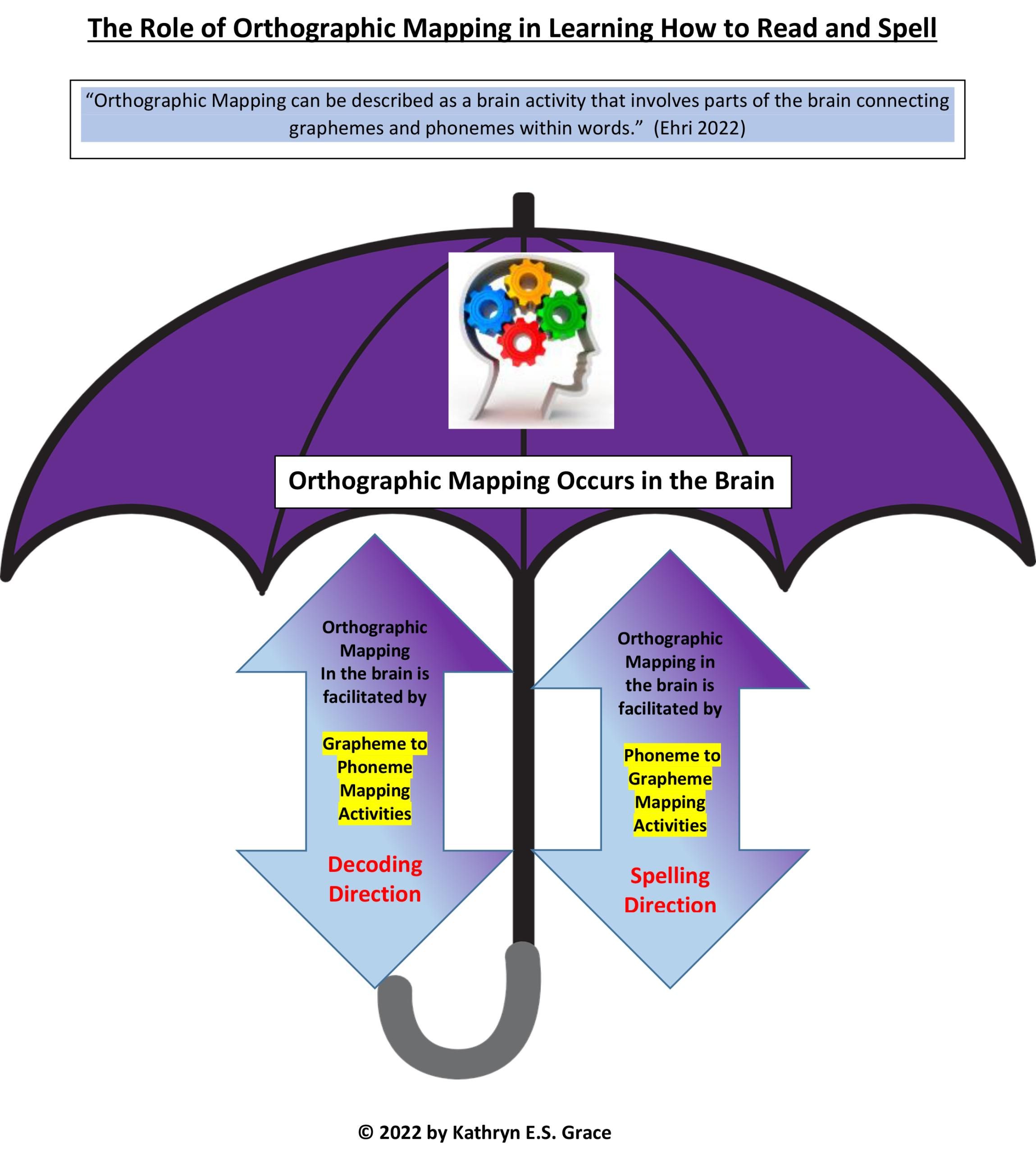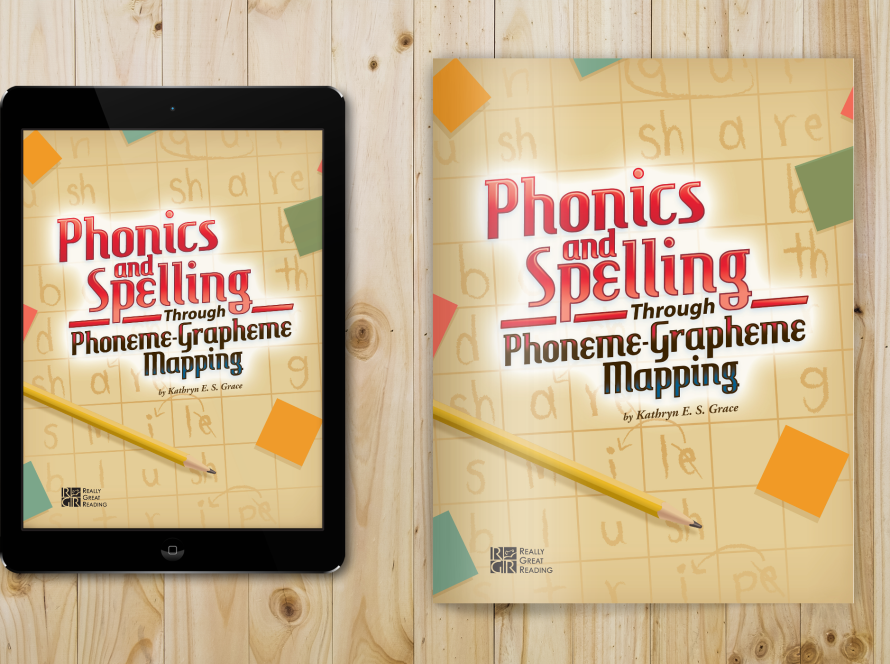“Orthographic mapping is a brain activity that involves parts of the brain connecting graphemes and phonemes within words.” (Ehri 2022) Orthographic maps are set up in the brain when decoding and spelling activities are performed. This allows a word to become embedded in long term memory as a unique letter string after it has been seen and read at least a few times. Activation of these connections acts like glue to bond the spellings of words to their pronunciations in memory along with meanings which then fosters instant recognition. (Ehri, 2021)
Since orthographic mapping is bidirectional, phoneme to grapheme mapping and grapheme to phoneme mapping help bond spellings to their pronunciations in memory. “This occurs when words are decoded, by sounding out letters and blending them to form pronunciations.” Dr. Ehri’s studies have shown that “spellings of words influence the phonemes that students perceive in words. For example, pitch is perceived as having an extra /t/ in a phoneme segmentation task whereas rich is not.” Children “need to know how to distinguish phonemes within pronunciations of words and how these map onto graphemes within the spellings of words. Both print and speech are involved.” (Ehri 2022)

Neither Orthographic Mapping , Phoneme-Grapheme Mapping nor its inverse Grapheme to Phoneme Mapping are the same as learning words by memorizing their shapes – a practice frequently employed “to help” children retain sight words without referring to the phoneme-grapheme properties of the word. Research has shown that proficient readers do not automatically go from images of words to their meanings.
For decades, Dr. Linnea Ehri’s research has helped us understand the psychological processes and the sources of reading and spelling difficulty. Her studies have underscored the importance of beginning readers acquiring knowledge of our alphabetic writing system. Her research on how readers use their knowledge of phoneme-grapheme connections (as well as grapheme-phoneme connections) to retain sight words in memory has contributed greatly to the science of teaching reading.
Reading words can take several forms. Readers may use decoding, predicting, or analogy to read unfamiliar words. However, familiar words are accessed in memory which is commonly referred to as sight word reading. With practice, all words can eventually be read automatically by sight – the most efficient, unobtrusive way to read words in running text. (Ehri, 2005). However, this process involves making connections between phonemes (sounds) and graphemes (letter/s) or vice versa to bond the spelling of these words to their pronunciations and meanings in memory.
Dr. Linnea Ehri’s research regarding the Development of sight word reading: Phases and Findings (2005) helped lay the groundwork for understanding how children remember words. She found that being able to access words from memory (by sight) is extremely valuable because it allows readers to focus their attention on constructing the meaning of the text while their eyes automatically recognize individual words. Ehri characterized the development of sight word learning through a sequence of four overlapping phases that she distinguished by the type of alphabetic knowledge needed to form connections in the brain. She concluded that skilled reading is the ability to read individual words accurately and quickly as well as in isolation and within connected text.
Professor Stanislaus Dehaene, a French neuroscientist and author of Reading in the Brain: The New Science of How We Read (2010) further acknowledged the brain’s contribution to learning to read. His research revealed that the brain has areas that are shared between spoken and written language and they are present in your brain when you are very young – even before you learn to read. He also noted that reading involves creating an interface between the vision system in your brain and your spoken language system. “An entire series of mental and cerebral operations must occur before a word can be decoded. Our brain takes each string apart then recomposes it into a hierarchy of letters, bigrams, syllables and morphemes. Effortless reading simply serves to show that these decomposition and recomposition stages have become entirely automatic and unconscious.” (Dehaene, 2010) His findings have been supported by neuroimaging and eye tracking research that demonstrated how skilled readers process every single letter of the printed word from left to right and in parallel so quickly and automatically that it is even unnoticeable to the reader. He further concludes that “Whole-word reading is a myth” since “the brain processes every single letter and does not look at the whole word shape.”
Dr. Ehri published “Orthographic Mapping in the Acquisition of Sight Word Reading, Spelling Memory, and Vocabulary Learning” in 2014. According to her theory and evidence, she concluded that “spellings of words are retained in memory when their letters become bonded to phonemes and syllables in their pronunciations. Many practitioners have limited their definition of sight words to high-frequency or irregularly spelled words. However, Ehri notes “all words when practiced become read from memory by sight.” (2014) Orthographic mapping occurs in the brain while reading specific words when readers form connections between written units and spoken units. These can be either phonemes, syllables or morphemes in speech or single graphemes or larger spelling patterns in print. These connections are then stored in memory with their word meanings and enable readers to recognize the words by sight. As the spellings of words enter memory via orthographic memory, they also influence the phonological processing of words, phonological memory and vocabulary.
In Dr. David Kilpatrick’s book, Essentials of Assessing, Preventing, and Overcoming Reading Difficulties (2019), he described orthographic mapping as “the mental process we use to permanently store words for immediate, effortless retrieval”. It allows us to take an unfamiliar printed word and turn it into an immediately recognizable word. However, this is not the same as memorizing the way a word “looks”. With OM, our brain simultaneously processes the letters we see with our eyes and the sounds we hear in the word so they are stored together in the brain. Dr. Kilpatrick writes that “Orthographic Mapping is not a skill, teaching technique or activity you can do with students.” However, phonemic awareness and phonics skills can be taught which greatly facilitate the brain’s orthographic mapping of the word. (Kilpatrick, 2019)
In my recent exchange with Dr. Ehri, she expressed that, “Teaching children to decode is teaching them orthographic mapping. Teaching them to analyze grapheme-phoneme relationships within [words] to determine how the spellings of words map onto their pronunciations is orthographic mapping. Teaching children to remember the spellings of words by remembering how phonemes are represented by graphemes within the word is orthographic mapping.” (Ehri, 2022)
It is much easier to remember something if it is connected to something you already know. Since we learn to speak long before we learn to read, students frequently already know a word’s pronunciation and meaning through listening and speaking activities which help to store them in long term memory. Dr. Kilpatrick notes, “Orthographic mapping proposes that we use the pronunciations of words that are already stored in long-term memory as the anchoring points for the orthographic sequences (letters) used to represent those pronunciations.” Therefore, a written word is turned into a sight word through orthographic mapping by attaching the sounds (phonemes) in the word’s pronunciation to the word’s letter sequence (grapheme(s) that have been stored in the brain. For this to occur, the word needs to be split into its individual phonemes so strong phonemic awareness skills are extremely important.
Learning to read is key to a child’s success in achieving skilled reading. The accrual of written words in memory is ongoing and orthographic mapping processes underlie the development of a student’s skill in reading words accurately and automatically from memory. Alphabetic knowledge is essential to connect spellings to pronunciations and for retaining sight words in memory. This is an internal process that is spontaneously activated when we see, hear or orally produce words. Therefore, it is crucial we teach students the knowledge and skills they need to ensure these essential connections are activated when they see or read words.
Orthographic Mapping in the brain is facilitated by the following:
1. Proficient phonemic awareness or the ability to segment spoken words into their smallest sounds (or phonemes) and to blend the phonemes into recognizable words.
2. Automatic letter-sound correspondences or the mastery of the major letter-sound relationships that comprise the writing system. By understanding the relationship of the letters in the alphabet to the sounds they produce, children are better able to decode unfamiliar words by sounding out letters and blending them to form words. By forming connections between individual graphemes in the spelling of specific words and their respective phonemes in pronunciation and vice versa, children are better able to store sight words in memory via the process of orthographic mapping.
3. An understanding of the alphabetic principle or the knowledge that letter or groups of letters (grapheme/s) match individual sounds (phonemes) in words and there may not always be a one to one correspondence between the sound(s) you hear and the letter(s) you write. .
It is imperative that early learners acquire a practical knowledge of phoneme/grapheme and grapheme/phoneme correspondences and recognize it is a bidirectional process that has become unitized and can be applied to both decoding and spelling. (Ehri, 2022) This helps learners develop an accumulation of words they can read fluently via phonological recoding which allows them to later transfer this information about known words to help decode unknown words. By connecting the sounds (phonemes) in oral words to the letter/s (grapheme/s) in written words, children are able to lock the words in memory via orthographic mapping for fast, efficient retrieval in the future.
The attached diagram depicts the role of orthographic mapping (OM) in learning to read and spell. It also demonstrates how the processes of phoneme-grapheme mapping and its inverse (grapheme-phoneme mapping) are essential facilitators of OM in the brain so children can more effectively retain these relationships for more automatic retrieval of words during reading, spelling and vocabulary tasks.
An effective word study program is essential to help students make connections between what they hear and what they see or write so they can be orthographically mapped in the brain. Phoneme-Grapheme Mapping and its reciprocal process of grapheme-phoneme mapping are effective methods for facilitating these important connections. Ultimately, this enables a child to read and spell individual words accurately and quickly so they can better retrieve them in isolation and within connected text.
Phoneme-Grapheme Mapping (Grace 1983) is an effective word study program that incorporates both phoneme/grapheme and grapheme/phoneme correspondences. It also facilitates Orthographic Mapping – the brain process that enables students to form connections between what they hear and what they see in print so they can retain it in memory for easier retrieval. Phoneme-Grapheme Mapping (PGM) is also a sequential, systematic, multi-sensory process that helps students better understand the alphabetic principle – that is the number of sounds they hear in a word may be different from the number of letter/s (grapheme/s) that represent those sounds. PGM also supports the development of automaticity and fluency in both reading and spelling and helps children visualize the connections between the two. By mapping sounds to print via Phoneme-Grapheme Mapping, students acquire a metacognitive approach to decoding, spelling, and reading connected text.
References:
Dehaene, S. (2010). Reading in the Brain: The New Science of How We Read. New York: Penguin Books.
Ehri, L. (1984). “How Orthography alters spoken language competencies in children learning to read and spell”. In J. Downing & R. Valtin (Eds.), Language awareness and learning to read (pp. 119–147). New York, NY: Springer Verlag.
Ehri, L. (1987). “Learning to read and spell words”. Journal of Reading Behavior, 14, 5–31.
Ehri, L. (1992). “Re-conceptualizing the development of sight word reading and its relationship to recoding.”
Ehri, L. (1998). “Grapheme–phoneme knowledge is essential for learning to read words in English”. I
Ehri, L. (2005a) “Development of sight word reading: Phases and findings”. In M. Snowling & C. Hulme (Eds.), the science of reading: A handbook (pp. 135–154). Malden, MA: Blackwell.
Ehri (2014) “Orthographic Mapping in the Acquisition of Sight Word Reading, Spelling Memory, and Vocabulary” Learning, Scientific Studies of Reading, 18:1, 5-21, DOI: 10.1080/10888438.2013.819356
Ehri (2022). Upon review of Kathryn Grace’s article, “The Role of Orthographic Mapping and Phoneme-Grapheme Mapping in Learning to Read and Spell”
Kilpatrick, D. A. (2016). Equipped for reading success: A comprehensive, step-by-step program for developing phonemic awareness and fluent word recognition. Syracuse, NY: Casey & Kirsch Publishers.
Peltier, Tiffany (2021). “Dr. Linnea Ehri’s List of Instructional Guidelines for Enhancing Orthographic Mapping and Word Learning”. Understanding the Science of Reading blog https://understandingreading.home.blog/2021/04/18/dr-linnea-ehris-list-of-instructional-guidelines-for-enhancing-orthographic-mapping-and-word-learning/






1 Comment
Comments are closed.